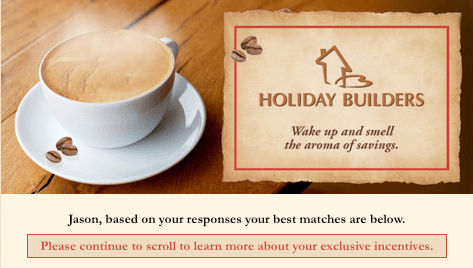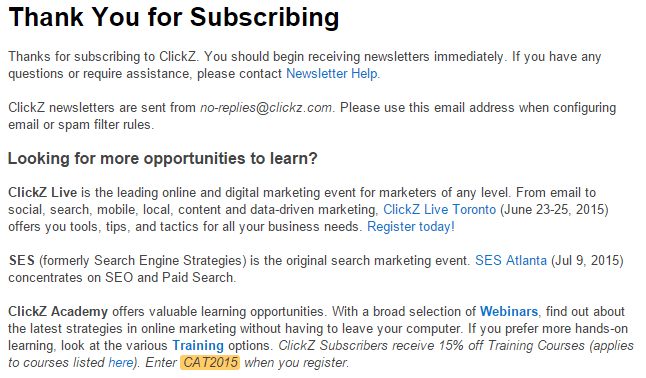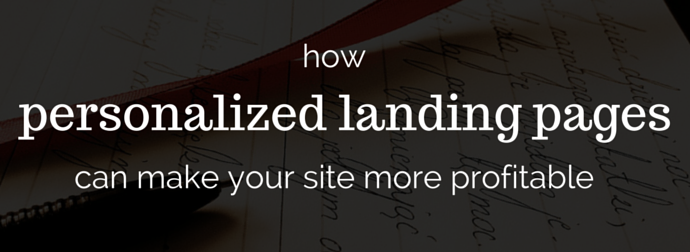- Home
- Blog
- Web Design
- How Personalized Landing Pages Can Make Your Site More Profitable
How Personalized Landing Pages Can Make Your Site More Profitable
-
 8 min. read
8 min. read
- Summarize in ChatGPT
-
 Trevin Shirey
Trevin Shirey VP of Marketing
VP of Marketing
- Trevin serves as the VP of Marketing at WebFX. He has worked on over 450 marketing campaigns and has been building websites for over 25 years. His work has been featured by Search Engine Land, USA Today, Fast Company and Inc. Read his review of working with WebFX for the last 15 years.
Personalization is one of the most effective marketing techniques to connect with customers online. While the exact methods are different for every business, adding personalized elements to landing pages is a proven method of driving conversions on your site. But why is it so successful?
The simple answer is that personalization shows customers that you care. You traveled the extra mile to tell John Smith of Generictown, Statename that you hope he’s doing well — that speaks volumes to your consideration as a company. While personalization previously existed in emails, messages, and sales pitches, many businesses are successfully incorporating it into a wider variety of their marketing materials. You can now personalize almost any aspect of your marketing strategy — but one of the most profitable is the landing pages on your site.
How personalized landing pages can make your site more profitable
From a marketing point of view, the biggest advantage of personalized landing pages is the relationship you immediately begin to build with your visitor.
You’re not just talking to them in generic terms in black and white — you’re rolling out the red carpet, taking them by the shoulder, and showing them that you care about their needs. As a result, your visitors are far more likely to trust you. You can even analyze your visitors’ on-site behavior, speak to them directly, or interact with them in other ways based on their exact personalities.
From a business perspective, the biggest advantage of personalization is a 42% increase in the success rates of your calls to action. Are you trying to get visitors to fill out a contact sheet? Try out a software demo?
Return to their shopping cart? Accost them directly with a soft sales pitch and some personal information to get them in the game.
What to base your personalization on
You can base your personalization on a number of different traits, all of which give site visitors an incentive to use your services. All of this data can be found with analytics tracking software, which will show you the nitty-gritty on visitor interaction on your website.
If you don’t already have it set up, Google Analytics is a great place to start.
Location
If you couldn’t guess, this refers to the physical location of a visitor based on their registered IP address. Location tagging allows you to start off your personalized landing page with a quick reference to a user’s home locale. A landing page with a form, for instance, could auto-fill a form field for country or state.
Page content
Page content refers to the articles, blogs, and other webpages a user has visited on your site.
If you track their habits and time on each page, you can gauge their interest levels in certain topics and appeal to them with future blog posts or articles. The more information you create on that topic, the more they’ll want to stick around.
Referring websites
Referring websites are other domains that funnel traffic to your website via links. By creating landing pages (you can use a landing page creation tool for this) based on where a visitor came from, you can also tailor your content to match their interests.
PPC ads
If you decide to run pay-per-click (PPC) ads anywhere online, you should absolutely link them to personalized landing pages.
You can customize visitors’ experiences based on the specific sales hook that caught their eye, ensuring you continually earn their attention. Basically, you give them more of what you know they already like. This metric can also double as a way to check how well your ads and sales text are performing.
Previous actions on your site
If a visitor has already been to your site and filled out a contact form, you have a wealth of information to use for personalization.
Be careful not to scare them off by being too personal, but a quick “Welcome back, Tim!” is a great way to make your site feel a little warmer.
What to personalize
Now that you have the basis for personalization, you can choose the pages you want to customize.
Content
Custom content pages work great when they’re based on names, locations, and similar factors to offer visitors a warm welcome. Holiday Builders provides a great example, appealing to a customer by name, enticing him to continue reading, and offering him exclusive deals:  By narrowing down the offers they present to each visitor based on a visitor’s interests, they minimize the chances of overwhelming customers with too much information. Sometimes the best approach is a light touch that just shows a customer you’re happy they’re on your site.
By narrowing down the offers they present to each visitor based on a visitor’s interests, they minimize the chances of overwhelming customers with too much information. Sometimes the best approach is a light touch that just shows a customer you’re happy they’re on your site.
Thank you pages
After a customer takes a specific action (opts into an email list, fills out a contact form, makes a purchase, etc.), they will leave your site unless you give them a reason to stay.
To keep their attention, you can create a personalized landing page based on their actions and suggest what they can do next. For example, I told ClickZ that I like marketing news when I signed up for their newsletter, and they had some good ideas on what I might like next — they even gave me the links:  Instead of a simple “thank you,” they used this page as a way to get me to stick around. And with six different links on the page, I have a lot of reasons to stay — and maybe even sign up for something else.
Instead of a simple “thank you,” they used this page as a way to get me to stick around. And with six different links on the page, I have a lot of reasons to stay — and maybe even sign up for something else.
Offers
If a visitor comes to your site via a PPC ad, they are likely looking for a specific product.
Once they find it, recommend something else they might like to maximize their value. For example, I’ve shopped for enough thriller, improvement, and horror books online that Amazon can take a decent stab (so to speak) at what I want next:  These recommendations not only give me ideas as to what book I should read next, but they also increase the chances that I’ll purchase it from Amazon. Clearly they’ve noticed what I like, and they’re spot on — I want to see more of the same.
These recommendations not only give me ideas as to what book I should read next, but they also increase the chances that I’ll purchase it from Amazon. Clearly they’ve noticed what I like, and they’re spot on — I want to see more of the same.
Further reading
If you publish articles and blog posts on your site, you can suggest further reading at the bottom of your pages and link to other related content on your site.
For example, when I scrolled to the bottom of a blog post about marketing on Evergage, I saw this popup:  Instead of simply showing the most recent or popular blog post on their site, they choose to show one that is directly related to what I was reading. This personalization, along with the copy that conveys the message that it was hand-picked just for me, is a brilliant way to keep me on their site. And for the record, it totally worked.
Instead of simply showing the most recent or popular blog post on their site, they choose to show one that is directly related to what I was reading. This personalization, along with the copy that conveys the message that it was hand-picked just for me, is a brilliant way to keep me on their site. And for the record, it totally worked.
How to avoid going overboard
Naturally, there are a few areas where personalization can go wrong, though you can avoid them by simply reviewing your ideas before throttling them into action. In general, though, it’s better to err on the side of caution.
A little goes a long way with personalization — and a lot can easily go too far. First, don’t use excessive amounts of personalization data. Displaying someone’s name, town, or previous habits on your website is all well and good.
Displaying their exact street address, the exact time they last visited your website, and emailing them when they close their browser are too much. The goal of personalization is to forge a lasting relationship between your company and your customers. You don’t want to make them feel like they’re being stalked.
Wording can also be an issue, specifically if it’s too demanding, harsh, or condescending. Avoid phrases that may make customers feel like they’re at fault, especially if they haven’t done anything yet (for example, “If you’re confused, contact us!” vs. “If you have any questions, contact us!”). In addition, using the proper jargon, offering relatable hypothetical situations, and describing scenarios in which your product can help someone are all excellent methods to use when appealing to specific visitors.
Our digital marketing campaigns impact the metrics that improve your bottom line.
See Our Approach
$10 billion

24 million

7.14 million
Looking for an agency that can help you create landing pages?
Not only can WebFX help you create stellar landing pages, but we can also help you create search ads, sponsored Facebook posts, and so much more.
-
 Trevin serves as the VP of Marketing at WebFX. He has worked on over 450 marketing campaigns and has been building websites for over 25 years. His work has been featured by Search Engine Land, USA Today, Fast Company and Inc. Read his review of working with WebFX for the last 15 years.
Trevin serves as the VP of Marketing at WebFX. He has worked on over 450 marketing campaigns and has been building websites for over 25 years. His work has been featured by Search Engine Land, USA Today, Fast Company and Inc. Read his review of working with WebFX for the last 15 years. -

WebFX is a full-service marketing agency with 1,100+ client reviews and a 4.9-star rating on Clutch! Find out how our expert team and revenue-accelerating tech can drive results for you! Learn more
Make estimating web design costs easy
Website design costs can be tricky to nail down. Get an instant estimate for a custom web design with our free website design cost calculator!
Try Our Free Web Design Cost Calculator


Web Design Calculator
Use our free tool to get a free, instant quote in under 60 seconds.
View Web Design Calculator
Proven Marketing Strategies
Make estimating web design costs easy
Website design costs can be tricky to nail down. Get an instant estimate for a custom web design with our free website design cost calculator!
Try Our Free Web Design Cost Calculator
What to read next





